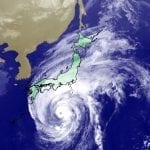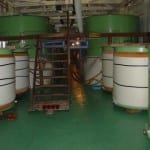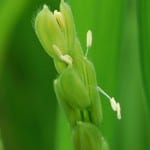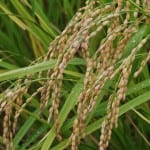Warmer temperatures and strong storms are not to be trivialized!
 The weather has been warmer the past few decades, and the environment has been much less stable overall. Japan is experiencing this as much as anywhere else, and while its effect on the sake world is not yet huge, everyone is aware of the changes and how they could impact things in the future. Sake production itself and, of course, rice growing are the two main things to consider.
The weather has been warmer the past few decades, and the environment has been much less stable overall. Japan is experiencing this as much as anywhere else, and while its effect on the sake world is not yet huge, everyone is aware of the changes and how they could impact things in the future. Sake production itself and, of course, rice growing are the two main things to consider.
Let’s look at production first. Of course, temperature is hugely important during sake production, as a difference of just a couple degrees during fermentation would lead to a completely different sake, in terms of both flavor and aroma. Basically, ginjo and daiginjo call for lower temperatures so as to stress out the yeast and extract all those fruity essences. Not that this kind of sake is the only game in town. But you know; I’m just sayin’.
But note, the industry pretty much has that covered. In the old days, sake brewing was much more at the mercy of nature. Kura (breweries) are built to be cold in the winter, and cooler than the outside in the summer. Thick earthen walls help that cause to some degree of course.
 But today, temperature control is much easier than in the past. Tanks can be concentrated into smaller space than in the past, and those rooms within the kura can be further insulated and cooled with modern climate control equipment, no problem. Individual tanks themselves can be chilled too, with all kind of tools now available such as jackets through which coolant can be run. Jury-rigged versions like garden hoses running chilled water can also be used for more budget-conscious breweries.
But today, temperature control is much easier than in the past. Tanks can be concentrated into smaller space than in the past, and those rooms within the kura can be further insulated and cooled with modern climate control equipment, no problem. Individual tanks themselves can be chilled too, with all kind of tools now available such as jackets through which coolant can be run. Jury-rigged versions like garden hoses running chilled water can also be used for more budget-conscious breweries.
So proper, well thought-out industrial design can solve a lot of these problems. On top of that, there are also those breweries (like Taketsuru in Hiroshima) that take the philosophy that it is better to just let nature have her way, and let that be expressed in the year’s sake.
In truth, it’s not really this simple, since temperature control calls for more resources and energy. As time passes, we all need to be increasingly aware of that too as it can be part of the problem. The sake industry is not a large industry, and is just a drop in the bucket of energy consumption. But we still need to be conscious of such things.
Rice growing is another issue altogether. While changes are indeed apparent, thus far they are manageable rather than massive. But even bigger changes are afoot for sure.
For example, even though the climate has changed, the best Yamada Nishiki still comes from the same microclimates – such as Tojo and Yokawa – in Hyogo Prefecture, and the amount of top-quality rice that is harvested each year has not declined.
 Surely modern technology in all areas helps this. For example, weather radar lenabled everyone to see the massive typhoon Hagibis that engulfed Japan in early October. This allowed the farmers growing Yamada Nishiki to quickly harvest the rice – albeit a bit earlier than they would normally have done it. An early harvest is much better than a ruined one. More significantly, though, climate change affects things in ways beyond higher temperatures.
Surely modern technology in all areas helps this. For example, weather radar lenabled everyone to see the massive typhoon Hagibis that engulfed Japan in early October. This allowed the farmers growing Yamada Nishiki to quickly harvest the rice – albeit a bit earlier than they would normally have done it. An early harvest is much better than a ruined one. More significantly, though, climate change affects things in ways beyond higher temperatures.
There are other adaptations to the changing climate that are happening as well. For example, most good sake rice strains do not like colder temperatures, and so not much good sake rice has been grown in the northern parts of Japan. But as things warm up, the northernmost limit is getting nudged even further north.
Hokkaido, the northernmost of Japan’s four main islands, was long known for having not-so-good rice, to put it mildly. One brewer from there told me he found a company advertisement from the 80s that bragged – not stated but bragged – that all of their sake was made with rice grown on the main island of Japan, and not in Hokkaido!
But over the past decade or so, things have changed. There are several very good strains of sake rice being grown in Hokkaido, and the rice-growing industry there is actively marketing it to the rest of the country, and successfully so.
As an interesting anecdote related to this, Saga Prefecture is part of Japan’s southernmost of the four major islands, Kyushu. Plenty of good sake rice is grown there, including the aforementioned and sometimes overly adulated Yamada Nishiki. But one brewer I spoke to from Saga is going out of his way to buy and brew with rice from Hokkaido. Why would he bother with this when there is so much good rice locally available?
 Because he has his eye on the future. He feels that in time, good sake rice production may move further north. So he wants to get experience with the rice from that region and learn to make increasingly better sake with it. And, furthermore, he wants to open the channel of distribution and establish a relationship with the rice-producing industry up there, so that when Hokkaido rice gets more attention, he will enjoy the benefits of having developed a long-term, mutually beneficial relationship that will afford him preferential status.
Because he has his eye on the future. He feels that in time, good sake rice production may move further north. So he wants to get experience with the rice from that region and learn to make increasingly better sake with it. And, furthermore, he wants to open the channel of distribution and establish a relationship with the rice-producing industry up there, so that when Hokkaido rice gets more attention, he will enjoy the benefits of having developed a long-term, mutually beneficial relationship that will afford him preferential status.
Hopefully, we will all act in concert to slow down climate change and take better care of the planet. But the sake brewing industry is already pondering a handful of Plan B options. Let us see how it unfolds over time.
 Know more. Appreciate more.
Know more. Appreciate more.
Announcing the launch of a new sake publication, Sake Industry News, a twice-monthly newsletter covering news from within the sake industry in Japan. Free until December 1! Subscribe before then and enjoy an 20% discount for ever. Learn more here.




